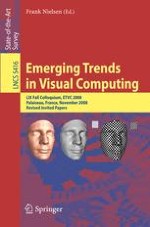2009 | OriginalPaper | Buchkapitel
Statistical Computing on Manifolds: From Riemannian Geometry to Computational Anatomy
verfasst von : Xavier Pennec
Erschienen in: Emerging Trends in Visual Computing
Verlag: Springer Berlin Heidelberg
Aktivieren Sie unsere intelligente Suche, um passende Fachinhalte oder Patente zu finden.
Wählen Sie Textabschnitte aus um mit Künstlicher Intelligenz passenden Patente zu finden. powered by
Markieren Sie Textabschnitte, um KI-gestützt weitere passende Inhalte zu finden. powered by
Computational anatomy is an emerging discipline that aims at analyzing and modeling the individual anatomy of organs and their biological variability across a population. The goal is not only to model the normal variations among a population, but also discover morphological differences between normal and pathological populations, and possibly to detect, model and classify the pathologies from structural abnormalities. Applications are very important both in neuroscience, to minimize the influence of the anatomical variability in functional group analysis, and in medical imaging, to better drive the adaptation of generic models of the anatomy (atlas) into patient-specific data (personalization).
However, understanding and modeling the shape of organs is made difficult by the absence of physical models for comparing different subjects, the complexity of shapes, and the high number of degrees of freedom implied. Moreover, the geometric nature of the anatomical features usually extracted raises the need for statistics and computational methods on objects that do not belong to standard Euclidean spaces. We investigate in this chapter the Riemannian metric as a basis for developing generic algorithms to compute on manifolds. We show that few computational tools derived from this structure can be used in practice as the atoms to build more complex generic algorithms such as mean computation, Mahalanobis distance, interpolation, filtering and anisotropic diffusion on fields of geometric features. This computational framework is illustrated with the joint estimation and anisotropic smoothing of diffusion tensor images and with the modeling of the brain variability from sulcal lines.
